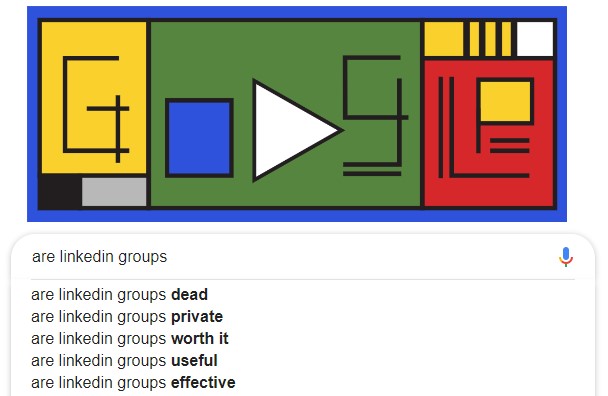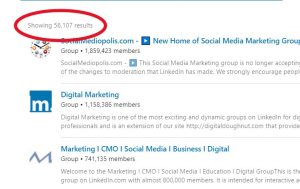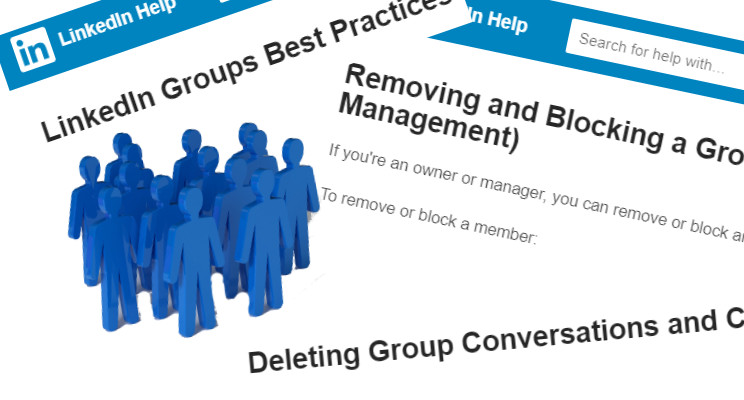LinkedIn Groups – What They Are
LinkedIn Groups are simply LinkedIn’s version of what used to be called Special Interest Groups (SIGs). These are just groups of people with an interest in a particular topic.
SIGs existed long before the internet, but when the web came along it was suddenly possible for people around the world to congregate on online member forums or bulletin boards.
Many SIGs online were technical in nature, largely because these users were early adopters of technology. Before search became a thing, and long before LinkedIn, groups of people with a particular interest in a topic would likely already be deeply involved in their subject through their work, membership of professional bodies, reading specialist magazines and journals and even travelling to events and conferences where they would meet real people!
Groups on LinkedIn were supposed to be a convenient way for those with a special interest to gather and communicate about their specialist subject. A platform like LinkedIn should have been a great place for this to happen. It has a large body of professionals across all sectors. With messaging and news feeds already built in and with the ability to post links and images, a LinkedIn Group often made more sense that older technologies that supported bulletin boards and member forums on websites.
On LinkedIn, it was easy to set up a group, find and invite people who might want to join.
So what went wrong with LinkedIn Groups?
If you are on LinkedIn, you will probably already be a member of a few LinkedIn Groups. When you signed up, LinkedIn probably prompted you to sign up for some groups along with asking you to follow some ‘influencers’.
You might have found a few groups that were of interest, maybe even contributed by asking or answering a few questions and perhaps made a few connections.
Over time, however, you probably noticed more and more sales posts, job posts from recruiters and just irrelevant spam completely unrelated to the special interest of the group. Gradually the genuine content was overwhelmed by the rubbish, a process accelerated by members just abandoning the group to marketers and recruiters.
A big problem with LinkedIn Groups was that it wasn’t long before many marketers realised that LinkedIn Groups weren’t just a good place for people with a special interest to meet online, they were also a good place to target an audience for whatever product or service you were selling.
Some sales and marketing people looked at LinkedIn Groups as an extension of their mailing list and flooded them with ‘special offers’ while making no contribution to the group at all.
Many recruiters looked at LinkedIn Groups as a ready-made talent pool for them to spam with jobs (real or not) and to badger members with job offers.
Is there still value in LinkedIn Groups?

If you believe much of what you read from the ‘experts’ LinkedIn Groups are ‘dead’ or a ‘waste of time’ or no longer fit for purpose.
Most of this kind of talk comes from marketers and recruiters who lament that LinkedIn Groups used to be a really good source of leads/candidates but now are a waste of time.
However, the main reason LinkedIn Groups are a waste of time for marketers and recruiters is that their aggressive sales tactics either got them kicked out of groups or the ‘normal’ members just stopped visiting groups that were full of pushy marketing and job posts.
For ‘normal’ business users, there are still benefits to be had from being a member of a group. It can be a good way to keep up with what’s happening in your sector, get answers to technical questions, find out about new products and get advice and opinions from some real subject matter experts.
If you are already in a Group that has a good quality membership, is active and isn’t being spammed by marketers and recruiters, congratulations!
You will already know the benefits of this kind of group, but the water is now so muddied now that it can be difficult to find quality groups that are worth joining.
Read on to see how to find LinkedIn Groups of real value.
Finding Quality LinkedIn Groups
How many Groups are there on LinkedIn? At the time writing there are over 1.8m groups on LinkedIn.
That means there will likely be a LinkedIn Group for whatever your special interest is – in fact, there will likely be several. Your biggest problem will be finding the right one(s) that are worth joining. This is further complicated by the fact that many of the best LinkedIn Groups won’t be ‘standard’ public groups, so may not appear in search. For some sectors there are just so many groups available, it can be virtually impossible to find the ‘best’ Groups for you to join.
 A search for ‘Marketing’ in LinkedIn Groups throws up over 56,000 results. Good luck sorting through that lot! If you are targeting a smaller sector, for example, ‘Hydro Power’, you’ll get a more manageable 93 results. However, that’s still a lot to work through. To speed up the process, here are our tips for finding quality groups.
A search for ‘Marketing’ in LinkedIn Groups throws up over 56,000 results. Good luck sorting through that lot! If you are targeting a smaller sector, for example, ‘Hydro Power’, you’ll get a more manageable 93 results. However, that’s still a lot to work through. To speed up the process, here are our tips for finding quality groups.
Size – biggest isn’t always best, but (unless your sector is an incredibly small niche), you’ll want a group that has a decent number of members. Groups with very small numbers of users will either be new (in which case it might be worth joining) or simply abandoned. Very large groups in popular topics (like Marketing) will likely be full of spam and if active will generate way too much content to sort through. These are best avoided.
Who is the Owner? Is the LinkedIn Group owned by a subject matter expert? A Vendor? A Marketer? A Recruiter? While there are some exceptions, Groups owned or managed by Marketers and Recruiters are only there to build an audience for their own products and services. Some vendor owned LinkedIn Groups are of good quality, but bear in mind they are primarily there to promote their own products and are building an audience for that reason. Other members may be employees of the vendor, customers or just fans of the brand, so don’t expect complete unbiased content and discussion. Usually, the profile of the Group owner and managers will give a good indicator of the quality of the group.
Is the Group active? Have a look through the most recent posts and check the frequency and quality. If there are long periods between posts, or if only the owner and manager are posting regularly, best move on and look elsewhere.
What LinkedIn Groups are sector leaders involved in? You should know who the leading lights are in your sector. Check what LinkedIn Groups they belong to (if they are showing these in their profile). Check out those LinkedIn Groups to see if they are worth joining.
Can anyone join? Groups that are open to anyone may already be infected by spammers, pushy salespeople and lazy recruiters. Some open groups are well moderated and manage to keep out the dross, so have a look at the content to see if it is of value. Often the Group rules will give a good indication of whether the Groups is well-moderated.
Polish your profile. There are two main reasons for making sure your profile is relevant for the LinkedIn Groups that you might want to join. The first is that LinkedIn will suggest Groups to you based on your profile and activity on the site. So make sure your profile contains information relevant to the sectors you are interested in. The other reason is that when you request to join a LinkedIn Group, chances are that the owner or manager will have a look at your profile to see if you are likely to be worth having.
When you have found some good quality LinkedIn Groups, remember to invite those you think might add value. This can be a great way to make connections and to keep a Group vibrant and up to date.
We’ll be looking further at the best ways for businesses to use LinkedIn later the series, but don’t discount LinkedIn Groups as one way to help build your brand and network while gaining valuable information from your peers and leaders in your sector.
If you want to know more about making the best use of LinkedIn Groups for your business, get in touch and let’s talk about what you can achieve and the best way to go about it.
About Trade IT
Trade IT is all about using technology to improve your business processes. This might mean new kit, the latest app or software package – but more often than not it is about organising your business processes to optimal efficiency and empowering your staff with the right skills and tools be more productive.
If you have Office 365 or G-Suite or Zoho One, you probably aren’t taking full advantage of the capabilities you are already paying for.
The technology available to even the smallest organisations today is incredible – but few companies are taking advantage.
If you want to find out more about how you could improve your business processes and make everyone more productive without working any harder, fill in the email request form on the right and we’ll get right back to you.
Sources and Useful Links
https://www.linkedin.com/help/linkedin/topics/6380/6381/186
https://www.linkedin.com/help/linkedin/answers/Groups?
https://www.linkedin.com/help/linkedin/answer/59966
https://www.linkedin.com/help/linkedin/answer/59966
https://www.linkedin.com/help/linkedin/answer/186/finding-and-joining-a-linkedin-group?lang=en
https://marketingland.com/linkedin-set-to-launch-redesigned-groups-platform-by-end-of-august-246317
https://www.linkedin.com/help/linkedin/answer/61178
https://marketingland.com/linkedin-set-to-launch-redesigned-groups-platform-by-end-of-august-246317
Can we help?
Are you confused about how to make the best use of LinkedIn for your business?
Could your time – and that of your marketing team – be better spent elsewhere?
If you want to have a no-hype discussion about how LinkedIn might work for your business, fill in the form below and we’ll get right back to you.


Recent Comments